Tendinitis, Tendinopathy, Enthesitis: What’s what in the world of Tendons!
If you’ve ever had a tricky tendon problem, you’ve probably come across one of the words in our title. Perhaps you have psoriatic arthritis, ankylosing spondylitis or another rheumatic disease which has affected your tendons.
We know it can be confusing to see all these words and appreciate it might not be clear how to then get things better!
So keen to know what they all mean?
If the answer is YES, buckle up for today’s blog where I explain all these tricky tendon terms!
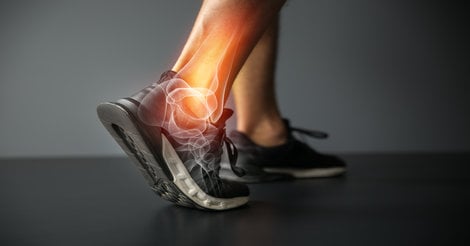
Before we get into the nitty gritty, it’s important that we refresh our understanding of what a tendon is. A tendon is a fibrous structure that connects a muscle to the adjacent bone. This allows the muscle to act on the skeleton and turn us from a floppy bag of bones to a functional moving human being. Pretty cool hey?
We have tendons blending into the ends of all of our skeletal muscles. They can vary from long thick tendons like the Achilles tendon, to wide flat attachment points like on the obliques below. The insertion point where the tendon meets the bone can be called the enthesis point (more on this later).
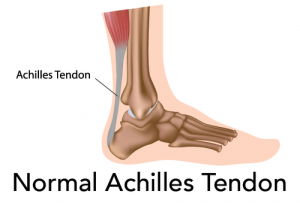

Tendons are made of thick parallel collagen strands- you could think of it like a packet of dry spaghetti! And when tendon tissue gets overloaded or affected by disease, it can become inflamed, disorganised, degenerative and just generally unhappy! This will typically manifest itself through pain, stiffness and an inability to do your normal activities.
When your Achilles tendon starts to become irritated, you may initially experience stiffness or pain in the morning or when getting up to go to the bathroom at night. You may even have the same stiffness if you are inactive for too long and you get up to go and move. Sometimes if you move or exercise enough the tendon may “warm up” and the pain will subside to a reasonable level. But this almost always leads to the tendon getting it’s payback- causing increased pain and stiffness once cooled down or even the following morning and day. I call this tendon revenge!
Now onto how we describe some of those tricky tendon terms!
Tendinitis
The suffix “itis” means inflammation. So tendinitis simply means inflammation of the tendon. In the early stages of tendon overload, your body will go through short term inflammatory processes to try and remedy the situation. This is often characterised by swelling, pain and even redness on or around the tendon. You can think of it like the swelling that occurs after you sprain your ankle- but to a lesser degree.
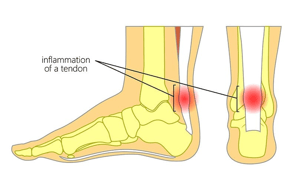
This could occur when you decide last minute to start running for an upcoming event. Another common time this can occur is when you increase your step count significantly whilst away on holiday. It could even happen when starting a new job which requires more hands on work. These quick changes to activity can be enough to cause inflammation in unprepared tendons.
If adequate rest is provided and your activity is resumed at a more appropriate level, these episodes can sometimes subside by themselves. Also if the load is not too much, the body may adapt to the increases as you continue to build up the activity. However, if the tendon continues to be excessively overloaded it can lead to tendinosis.
Tendinosis
Tendinosis occurs with overload to the tendon that occurs over a longer period of time (us clinicians would call this chronic) and leads to the degeneration and disorganisation of the tendon’s collagen structure. This thickening happens due to the low level inflammation and fluid remaining around the tendon. This process causes stiffness and an inability to handle the loads that we place through it. Think of it like putting water around the dry spaghetti from before- the strands become less uniform and softer. Good for eating but not so much for staying strong and active!
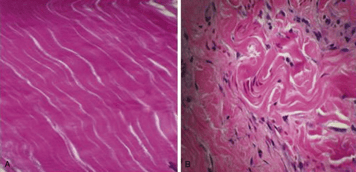 Normal tendon structure vs. Tendinopathy
Normal tendon structure vs. Tendinopathy
If the tendon has progressed to this stage rest will need to be accompanied by a specific exercise/ loading program to make sure the tendon regains full strength and capacity. Ice after activity, massage to the attaching muscle and other treatments may also be useful.
Tendinopathy
These days I mostly refer to tendon issues using the term tendinopathy. The suffix -”opathy” means disease or condition. So it essentially means a condition/ injury to the tendon. I use this word as it encapsulates the above conditions. We also now know that there is not as much inflammation as we once thought happening with tendon injuries. This could be due to the relatively small amounts of blood vessels and fluid in tendons.
Tendon injuries are also dynamic and on a spectrum- so there may be no one point where it transitions from one to the other. Scans are also not always reliable and consistent in classifying tendon injuries on investigations.
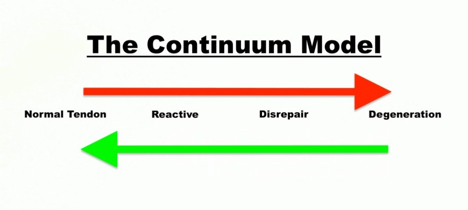
Enthesitis, Enthesopathy and inflammatory disease
As introduced earlier, the enthesis is the attachment point for the tendon. This issue could also be called an insertional tendinopathy. Essentially it is the same disease as what I have described above, just occurring at the attachment point. Once we know the location of the tendon inflammation, it can guide us health professional with the types of treatment or exercise we might do.
If there is enthesitis, especially without an obvious loading cause, we do need to consider why this is happening. Having worked closely with Rheumatologists over the last 5 years, I now know that some inflammatory conditions can cause inflammation at these tendon attachment points. It is therefore important that we clear these patients with a few questions.
- Family history of inflammatory conditions? (Rheumatoid or Psoriatic Arthritis, Ankylosing Spondylitis)
- Other areas of pain/ inflammation? (Other tendon attachments or joints/ spine)
- Raised inflammatory markers? (CRP, ESR on blood test)
If the answer to any of the above questions is “yes”, it’s important that you are reviewed by a Rheumatologist to determine whether there might be other underlying causes for your tricky tendons.
So if you've had any tendon issues and have further questions-please leave a comment or get in contact with the below button.
I hope that you have enjoyed this tendon run-down and that you now understand your condition down to the specific names! Knowledge is power.
Side note- Plantar Fasciitis/ Fasciopathy
This is a condition of the plantar fascia and appears just like a tendinopathy. If you want to learn more about about plantar fasciitis and the common reasons why it does not improve check out our previous blog here.
Feel free to subscribe to our blog for more advice on how to manage these challenging injuries. Or equally, click below to speak to one of our friendly Physio's who can help you manage any tricky, testy tendons!


